winter tires AUDI Q7 2014 Owner´s Manual
[x] Cancel search | Manufacturer: AUDI, Model Year: 2014, Model line: Q7, Model: AUDI Q7 2014Pages: 340, PDF Size: 85.02 MB
Page 31 of 340
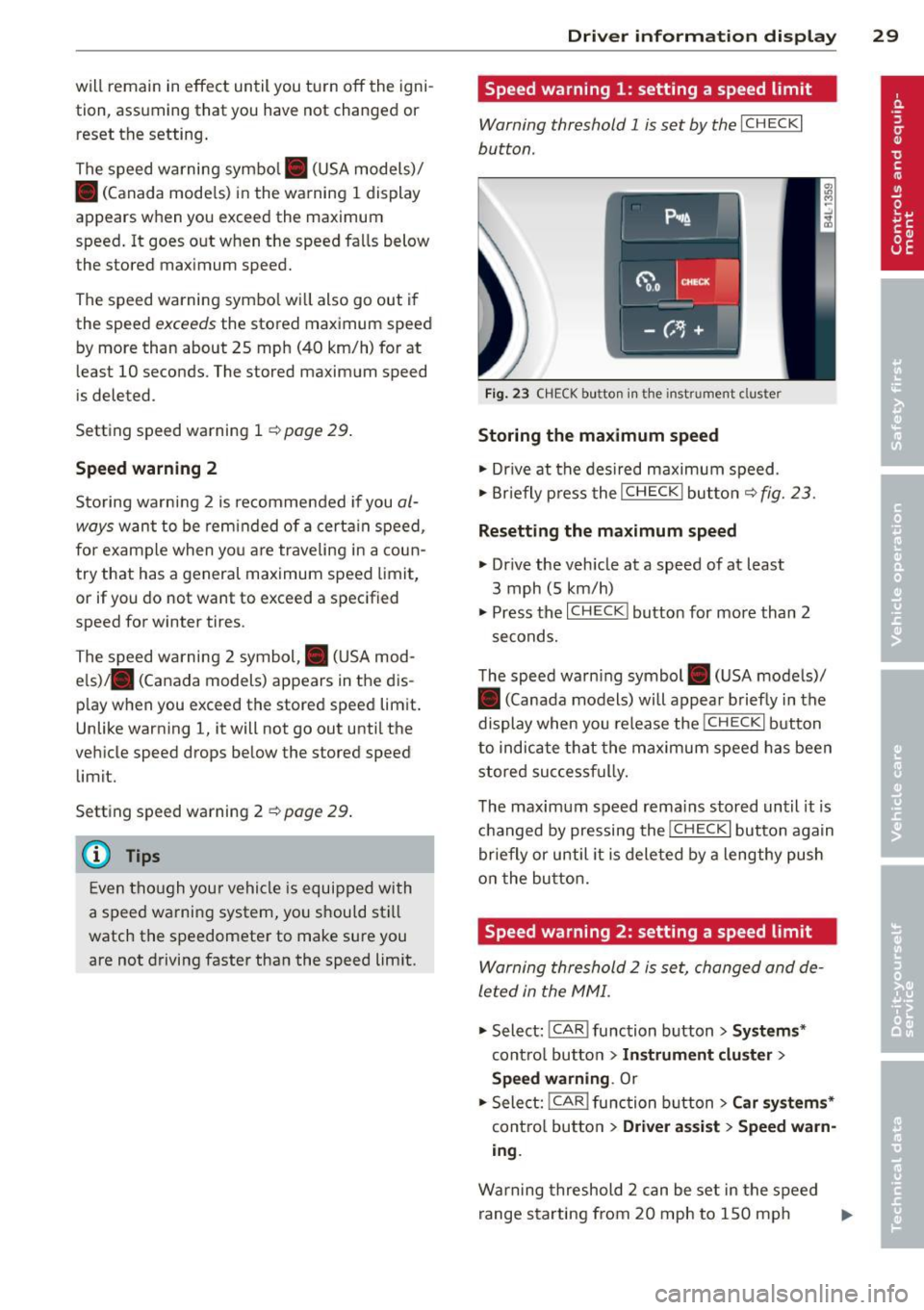
will remain in effect until you turn off the igni
tion, assum ing that you have not changed or
reset the setting.
The speed warning symbol. (USA models)/
• (Canada mode ls) in the warning 1 display
appears when you exceed the maximum
speed . It goes out when the speed falls below
t he stored maximum speed.
The speed warning symbo l wi ll also go out if
the speed exceeds the stored maximum speed
by more than about 2S mph (40 km/h) for at
least 10 seconds. The stored maximum speed
is deleted .
Setting speed warning 1 <:!;>page 29.
Speed warn ing 2
Storing warn ing 2 is recommended if you al
ways want to be reminded of a certa in speed ,
for example when you a re traveling in a coun
try that has a general maximum speed limit,
or if you do not want to exceed a specified
speed for winter tires .
The speed warning 2 symbol, . (USA mod
els)/ . (Canada models) appears in the d is
p lay when you exceed the stored speed limit.
Unlike warning 1, it will not go out unti l the
vehicle speed drop s below the stored speed
limit.
Setting speed warning 2
r:!;> page 29.
@ Tips
Even though your vehicle is equipped with
a speed warning system, you should sti ll
watch the speedometer to make sure you
are not driving faster than the speed lim it.
Dri ver inform ation di spl ay 29
Speed warning 1: setting a speed limit
Warning threshold 1 is set by the I CH ECKi
button .
Fig . 23 CHECK button in the instr umen t clu ster
Storing the ma ximum speed
.,. Dr ive at the desired maximum speed .
.,. Briefly p ress the
I CHECK I but to n c::> fig. 23.
Resetting the m aximum speed
.,. Dr ive the veh icle at a speed of at least
3 mph (5 km/h)
.,. Press the
I CHECK ! button for more than 2
seconds.
T he speed warn ing symbol . (USA models)/
• (Canada models) will appear briefly in the
display when you release the
!CH ECK I button
to indicate t hat the maximum speed has been
stored suc cessf ully.
T he maximum speed rema ins stored until it is
changed by pressing the
! CHECK I button again
briefly or until it is deleted by a lengthy push
o n the bu tton.
Speed warning 2: setting a speed limit
Warning threshold 2 is set, changed and de
le ted in the MMI .
.,. Select:
I CAR I function button > Sys tem s*
contro l button > In strum ent clu ste r >
Spe ed warning .
Or
.,. Select: !CAR I function b utton > C ar sy ste m s*
cont ro l butto n > Driver a ssist > Speed w arn
ing .
Warning threshold 2 can be set in the speed
range starting from 20 mph to 150 mph ..,.
Page 230 of 340
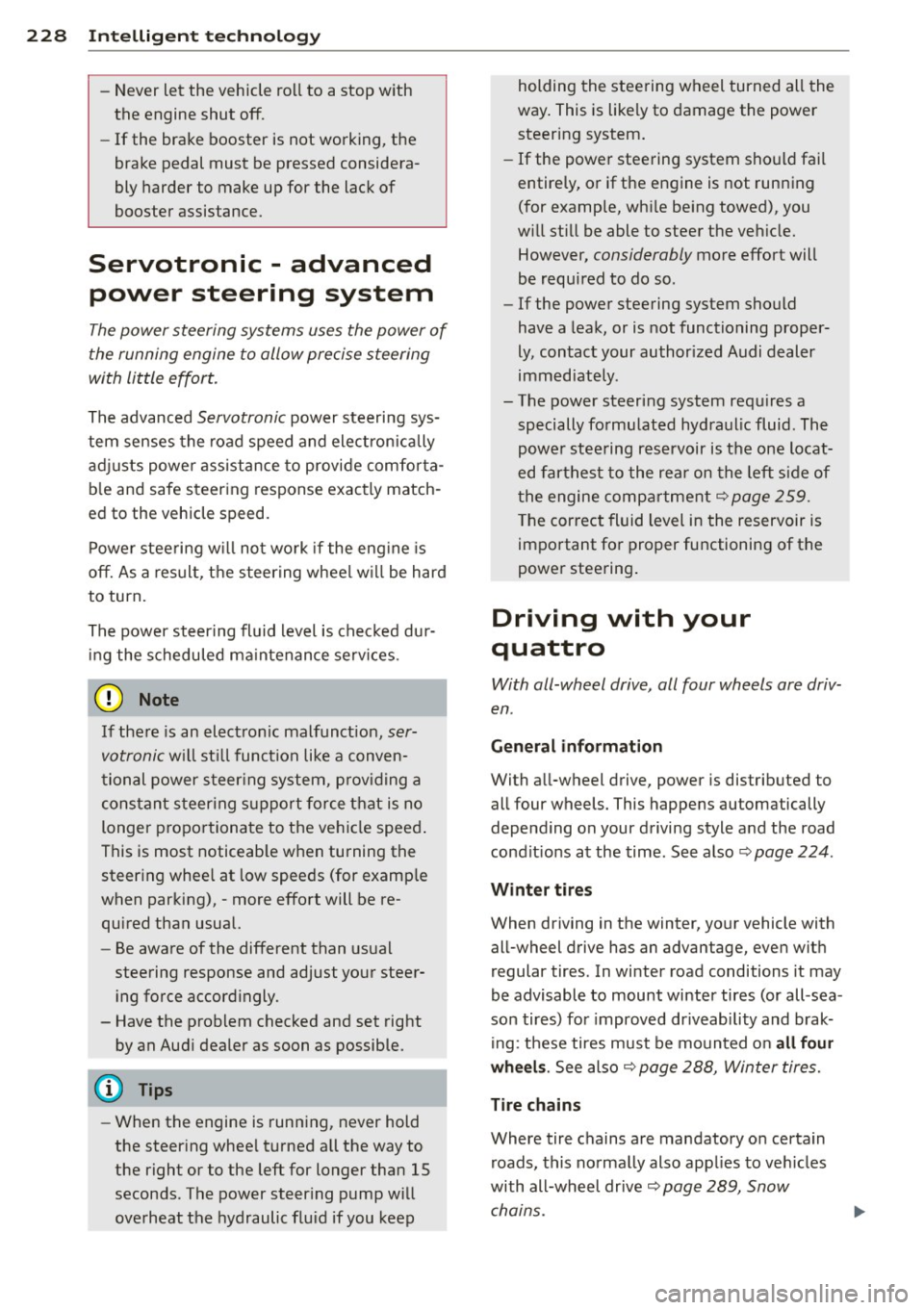
228 Intellig ent technol ogy
- Never let the vehicle ro ll to a stop with
the engine shut off.
- If the brake booster is not working, the
brake pedal must be pressed considera
bly harder to make up for the lack of
booster assistance.
Servotronic - advanced
power steering system
The power steering systems uses the power of
the running engine to allow precise steering
with little effort.
The advanced Servotronic power steering sys
tem senses the road speed and electronically
adjusts powe r assistance to provide comforta
b le and safe steering response exact ly match
ed to the vehicle speed.
Power steering w ill not work if the eng ine is
off. As a result, the steering wheel w ill be hard
to turn.
The power steering fluid level is checked dur
ing the scheduled ma intenance serv ices .
@ Note
If the re is an electronic malfunct ion, ser
votronic
w ill still function like a conven
tional power steer ing system, p roviding a
constant steer ing support force that is no
longer proportionate to the vehicle speed .
This is most noticeab le when turning the
steering whee l at low speeds (for examp le
when parking), -more effort will be re
quired than usual.
- Be aware of the different than usua l
steering response and adjust your steer i ng force accord ingly.
- Have the prob lem checked and set right
by an Aud i dealer as soon as possible.
- When the engine is running , never hold
the steering whee l turned all the way to
the right or to the left for longer than
15
seconds . The power steer ing pump w ill
overheat the hydraulic flu id if you keep holding the steering wheel turned all the
way . This is likely to damage the power
steering system.
- If the powe r stee ring system sho uld fail
entirely, or if the engine is not running
(for example, whi le be ing towed), you
will still be able to steer the ve hicle.
However,
considerably more effort will
be required to do so .
- If the power steering system should
have a leak, or is not functioning proper
ly, contact your author ized Audi dealer
immediately .
- The power steering system requ ires a
specially formulated hyd ra ulic fluid . The
powe r stee ring reservoir is the one locat
ed farthest to the rear on the left s ide of
the engine comp artment r=;,
page 259.
T he correct fluid level in the reservoir is
important for proper functioning of the
power steering .
Driving with your
quattro
With all-wheel drive , all four wheels are driv
en .
Gen eral information
With all-wheel drive, power is distributed to
all four wheels. This happens au toma tically
depending on your driving style and the road
condit ions at the time . See also r=;,
page 224 .
Winter tire s
When driving in the winter, yo ur vehicle with
a ll-wheel drive has an advantage, even wi th
regular tires . In winter road conditions it may
be advisable to mount winter tires (or all -sea
son tires) for improved dr iveability and brak
ing : these tires must be mounted o n
all four
wheels. See also r=;, page 288, Winter tires.
Tire chains
Where tire chains are mandatory on certain
roads, this normally also appl ies to veh icles
with all-wheel driver=;,
page 289, Snow
chains .
Page 247 of 340

Vehicl e ca re a nd cl eanin g 245
A WARNING
-Only wash the vehicle when the ignition
is off and follow the instructions from
the car wash operator to reduce the risk of accidents .
- To reduce the r isk of cuts, protect your
self from sharp metal components when
wash ing the underbody or the inside of
t he wheel housings.
- After washing the vehicle, the braking ef
fec t may be delayed due to mo isture on
the brake rotors or ice in the winter. The
brakes must be dried first with a few
careful brake applications.
Q) Note
- If you wash t he vehicle in an automatic
car wash, yo u must fold the exterior m ir
rors in to reduce the r is k of damage to
the mirrors. Power folding exterior mir
rors* must only be folded in and out us
ing the power folding function.
- Compare the track of your vehicle with
the distance between the guide rails of
the facility -there is a risk of damage to
the wheels and tires .
- Compare the height and width of your
vehicle with the he ight and width of the
tunnel at the fac ility. -
To prevent paint damage, do not wash
the vehicle in direct sunlight.
- T o reduce the r isk o f damage to the sur
face, do not use insect removing spong
es, kitchen sponges or similar items.
- Matte finish painted vehicle compo nents:
- To reduce the risk of damage to the
surface, do not use polishing agents or
ha rd wax .
- Never use car wash cycles that apply protective wax.
It can destroy the
matte fin ish effect .
- Do not place any stickers or magnet ic
signs on vehicle parts painted w ith
matte fin ish paint. The paint cou ld be
damaged when the stickers o r magnets
a re removed.
@ For the sake of the environment
Only wash the ve hicl e in facilities spec ially
designed for that purpose . This will red uce
the r is k of dirty water contam inated with
oil from entering the sewer system.
Cleaning and care information
When clean ing and caring for individual vehi
cle components, refer to the follow ing tables.
The information contained there is s imply rec
ommendations . For quest ions or for compo- nents that are not listed, refer to an author
ized Audi dealer or a qualified workshop. Also
follow the information found in c> ,& .
Cle aning e xterio r
Component Situation Solution
Wip er blades
Dirty c> page 66, Cleaning windshield wiper blades
Headlights / Dirty Soft sponge with a mild soap so lution a>
t a il lights
S en sor s/
Dirty Sensors: soft cloth w ith a so lvent-free cleaning product
camera len ses Camera lenses: soft cloth with an alcohol-free cleaning
so lution
Snow/ice Hand brush/solvent-free de -icing spray
•
•
Page 276 of 340
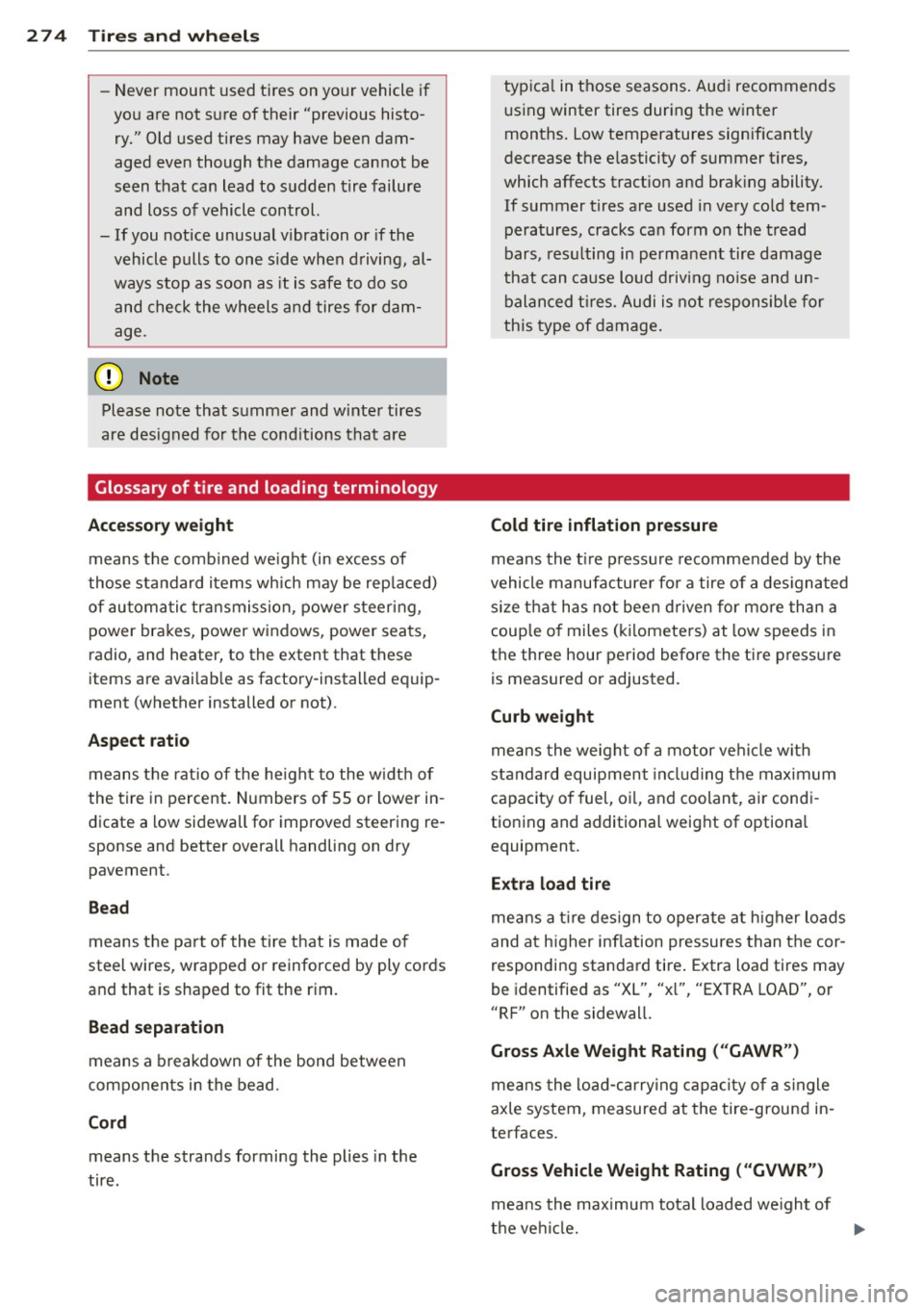
274 T ire s and wheel s
-Never mount used tires on yo ur vehicle if
you are not sure of their "previous histo
ry." Old used tires may have been dam
aged even though the damage cannot be
seen that can lead to sudden t ire failure
and loss of vehicle control.
- If you notice unusual vibration or if the
vehicle pulls to one side when driving, al
ways stop as soon as it is safe to do so
and check the wheels and tires for dam
age.
(D Note
Please note that summer and winter tires
are designed for the cond itions that are
Glossary of tire and loading terminology
Accessory weight
means t he comb ined we ight (in excess of
those sta ndard items which may be rep laced)
of au toma tic tra nsmission, power steer ing,
power brakes, power windows, power seats,
radio, and heater, to the extent that th ese
items are availab le as factory -installed equip
ment (whether installed or not) .
Aspect ratio
means t he ratio of the he ight to the w idth of
the tire in percent . Numbers of 55 or lower in
dicate a low sidewall for improved steering re
sponse and better overall handling on dry pavement .
Bead
means the part of the ti re that is made of
steel wires, wrapped or reinforced by ply cords
and that is shaped to fit the rim.
Bead separation
means a b reakdown of the bond between
components in the bead.
Cord
means the strands forming the plies in the
tire . typ
ica l in those seasons . Audi recommends
using winter tires during the winter
months . Low temperatures signif icant ly
decrease the e lasticity of summer tires,
which affects tract ion and brak ing ability.
If summer tires are used in very co ld tem
peratures, cracks ca n form on the tread
bars, res ulting in permanent tire damage
that can cause loud driving no ise and un
balan ced t ires. Audi is not responsible for
th is type of damage .
Cold tire inflation pressure
means the tire p ressu re recommended by t he
vehicle manufacturer fo r a tire of a des igna ted
s iz e that has not bee n driven for more than a
coup le of miles (k ilometers) at low speeds in
t h e three hour period before the tire pressure
is measured or adjusted.
Curb weight
mea ns the we ight of a motor ve hicl e w ith
standard equipment including the max imum
capacity of fuel, oil, and coolant, air condi
tioning and additional weight of optiona l
equipment.
Extra load tire
me ans a t ire design to operate at higher loads
and at h igher inflation pressures than the cor
responding standard tire . Extra load tires may
be identified as "XL", "x l" , "EXTRA LOAD", or
"RF" on the sidewall.
Gross A xle Weight Rating ("GAWR ")
means the lo ad -c a rry ing c apac ity of a s ingle
axle system , measured a t the tire-ground in
terfaces.
Gross Vehicle Weight Rating ("GVWR ")
mea ns the maximum total loaded we ight of
t h e ve hicl e. .,.
Page 278 of 340

2 76 Tires and wheels
Speed rating (letter code)
means t he speed at wh ic h a tir e is des igned to
be d riven for extended per io d s of t ime. The
ratings range from 93 mph (150 km/h) to
186 mph (298 km/h)
¢ page 285. You may
not find this informat ion on all tires because
it is not required by law.
The speed rating letter code, w here applica
b le, is molded on the tire sidewa ll and indi
cates the maxim um permissible road speeds
¢ &. in Winter tires on page 289.
Tire pres sure monitoring sy stem
means a sys tem that detects when one or
mo re of a vehicle's t ires are under inflated and
i l lum inates a low t ire p ress ure warn ing te ll
tale.
Tread
means t hat port ion of a tire tha t comes into
con tact w it h t he road.
Tread separation
means pull ing away of the t read from the t ire
car cass.
Treadwear indicators (TWI)
means t he p rojections withi n the pr inc ipal
g rooves desig ned to give a v isua l ind ication of
the deg rees of wear of the tre ad. See
¢
pag e 283, Tread W ear Indicator (TWI) for
mo re in format io n on measu ring tire we ar.
Uniform Tire Quality Grading
is a ti re i nfo rmation system developed by the
United States Nat io nal Highway Traffic Safety
Admin istration (N HTSA) that is designed to
h e lp buye rs make re lative compa risons among
tires. The UTQG i s not a s afety r ating and not a
g ua ran tee t hat a tire will las t fo r a presc ribed
n umber of m iles (kilome ters) or pe rform in a
certain way. It s imply gives tire b uye rs addi
tional information to combine with other con- s
iderations, such as p rice, b rand loya lty and
dealer recommendations. Un der UTQG, tires
are grade d by the t ire manufacturers in three
areas: treadwear, traction, and temperature
resistance. The UTQG informat ion on the tires,
molded into the sidewalls .
U.S. DOT Tire Identification Number (TIN)
T his is the tire's "se ria l number" It begins
with the letters "DOT" and ind icates that the
t ire meets all federa l standards. The next two
numbers o r letters ind icate the plant where it
was ma nufactu red, and the last four numbers
represe nt th e week and year of ma nufact ure.
For exampl e,
DOT ... 2213 ...
means that the tire was produced in t he 22nd
wee k of 2013. The other numbers are market
ing codes that may or may not be used by the
t ire manufacturer. This information is used to
contact consumers if a tire defect requires a
r ecall.
Vehicle capacity weight
means the rated cargo and luggage load plus
150 lbs. (68 k ilograms) times the vehicle's to
ta l seating capacity as listed on the label lo
cated on the driver's side B-p illa r.
Vehicle maximum lo ad on the tire
means that load on an individua l tire that is
determined by distributing to eac h ax le its
share of the maxim um loaded vehicle weight
and divid ing by two.
Vehicle normal load on the tire
means that load o n an individua l t ir e that is
determined by distrib uting to eac h ax le its
share of the curb weight, accessory weight, and normal occ upant weig ht (d istr ibuted in
accordance with tab le below¢
page 2 77)
and divid ing by two .
Page 287 of 340

contribution to good road holding and safe
handling when in good condition and properly
inflated
¢ .&. .
We recommend that all work on t ires and
wheels be performed by an authorized A udi
dealer. They are familiar with recommended
procedures and have the necessary spec ial
too ls and spare parts as we ll as the proper fa
cilities for dispos ing of the old tires .
Authorized Audi dealers have the necessary information about techn ica l requ irements for
installing or changing tires and r ims.
R eplacing t ires and wheel s
Tires shou ld be rep laced at least in pairs and
not individua lly (for example both front tires
or both rear tires together).
Be s ure to read and heed the information to
the tire pressure monitoring system
¢page 291.
Always buy rep lacement radial tires that have
the same specifications as the t ires approved
for your ve hicle by Audi. Replacement tires
must always have the same load rating speci
fication as the original equipment or approved
optional tires listed in the table
¢ page 277.
Aud i-approved specification tires are specially
matched to your vehicle and its load limits,
and can contribute to the important road hold
ing, driving character istics, and safety of the
veh icle. The table
(¢page 277) lists spec ifica
tions of the t ires approved for the Audi mod
e ls covered by your Owner's Literature .
The tire pressure labe l located on the driver's
side B-pillar
¢ page 2 77, fig. 250 lists the
specif ications of the or iginal equipment tires
installed on your vehicle at the time it was
manufactured.
Federal law requires t ire manufacturers to
p lace standard ized information on the s ide
wall of all tires
¢ fig . 253 . This information
i dent ifies and desc ribes the fundamental
characterist ics, the quality grade of the tire
and a lso provides a tire ide ntificat io n number
Tire s an d wheel s 285
for sa fety standard certification and in case of
a reca ll.
Tire specifications
Knowledge of tire specifications makes it eas
ier to choose the co rrec t tires . Radial ti res
have the tire specifications marked on the
sidewa ll, for examp le:
P255 / 55 R 18 109 H XL
This co nta ins the following information:
P Indicates the tire is for passenger cars
(where app licab le)
255 Nom inal tire width i n mm of the tire
from sidewall edge to sidewall edge. In
general, the larger the number, the wider
the tire
55 Height/w idth ratio in percent (aspect ra -
t io)
R Tire construct ion: Radial
18 Rim diameter code (i n inches)
10 9 Load ra ting code
H Speed ra ting letter code
XL (or "xl", "EXTRA LOAD", or "RF" Indicates
t h at the t ire is a"Re info rced" or an " Extra
Load " tir e
M+S (or "M/S") Indicates that the ti re has
some mud and snow capab ility
The tires could also have the informat ion of
direction of rotation ¢
page 273 .
Tire manufacturing d ate
The manufact uring date is also indicated on
the tire sidewall (possibly only on the
inner
s ide of the wheel):
"DOT ... 2213 .. . "means, for examp le, that
the tire was produced in the 22nd week of 2013.
Speed rating (letter cod e)
The speed rating letter code on the whee ls in
dicates the maximum permissible road speeds
¢ .&. in Winter tires on page 289.
P up to 93 mp h (150 km/h)
Q up to 99 mp h (1 58 km/h)
R up to 106 mph ( 170 km/h)
•
•
Page 289 of 340

-All four wheels must be fitted with radial
tires of the same type, size (rolling cir
cumference) and the same tread pattern .
Driving with different tires reduces vehi
cle handling and can lead to a loss of
control.
- If the spare tire is not the same as the
tires that are mounted on the vehicle -
for example with winter tires -only use
the spare tire for a short period of time and drive with extra care. Refit the nor
mal road wheel as soon as safely possi
ble.
- Never drive faster than the maximum
speed for which the tires on your vehicle
are rated because tires that are driven
faster than their rated speed can fail
suddenly.
- Overloading tires cause heat build-up,
sudden tire failure, including a blowout
and sudden deflation and loss of control.
- Temperature grades apply to tires that
are properly inflated and not over or un
derinflated .
- For technical reasons it is not always
possible to use wheels from other
vehicles -in some cases not even wheels
from the same vehicle model.
- If you install wheel trim discs on the ve
hicle wheels, make sure that the air flow
to the brakes is not blocked. Reduced air
flow to the brakes can them to overheat,
increasing stopping distances and caus
ing a collision.
- Run flat tires may only be used on
vehicles that were equipped with them at the factory. The vehicle must have a
chassis designed for run flat tires. Incor
rect use of run flat tires can lead to vehi
cle damage or accidents. Check with an
authorized Audi dealer or tire specialist
to see if your vehicle can be equipped
with run flat tires. If run flat tires are
used, they must be installed on all four
wheels . Mixing tire types is not permit
ted.
Tires and wheels 287
@ Note
- For technical reasons, it is not generally
possible to use the wheel rims from oth
er vehicles. This can hold true for wheels
of the same vehicle type.
- If the spare tire is different from the
tires that you have mounted on your ve
hicle (for example winter tires or wide
profile tires), then use the spare tire for a
short period of time only and drive with
extra care. Replace the flat tire with the
tire matching the others on your vehicle
as soon as possible.
- Never drive without the valve stem cap .
The valves could get damaged.
(® For the sake of the environment
Dispose of old tires in accordance with the
local requirements.
Uniform tire quality grading
- Tread wear
- Traction AA A B C
- Temperature ABC
Quality grades can be found where applicable
on the tire side wall between tread shoulder
and maximum section width
¢ page 284,
fig. 253.
For example: Tread wear 200, Traction AA,
Temperature A.
All passenger car tires must conform to Feder
al Safety Requirements in addition to these
grades.
Tread wear
The tread wear grade is a comparative rating
based on the wear rate of the tire when tested
under controlled conditions on a specified
government test course.
For example, a tire graded 1S0 would wear
one and one half (1 1/2) times as well on the
government course as a tire graded 100. •
•
Page 290 of 340
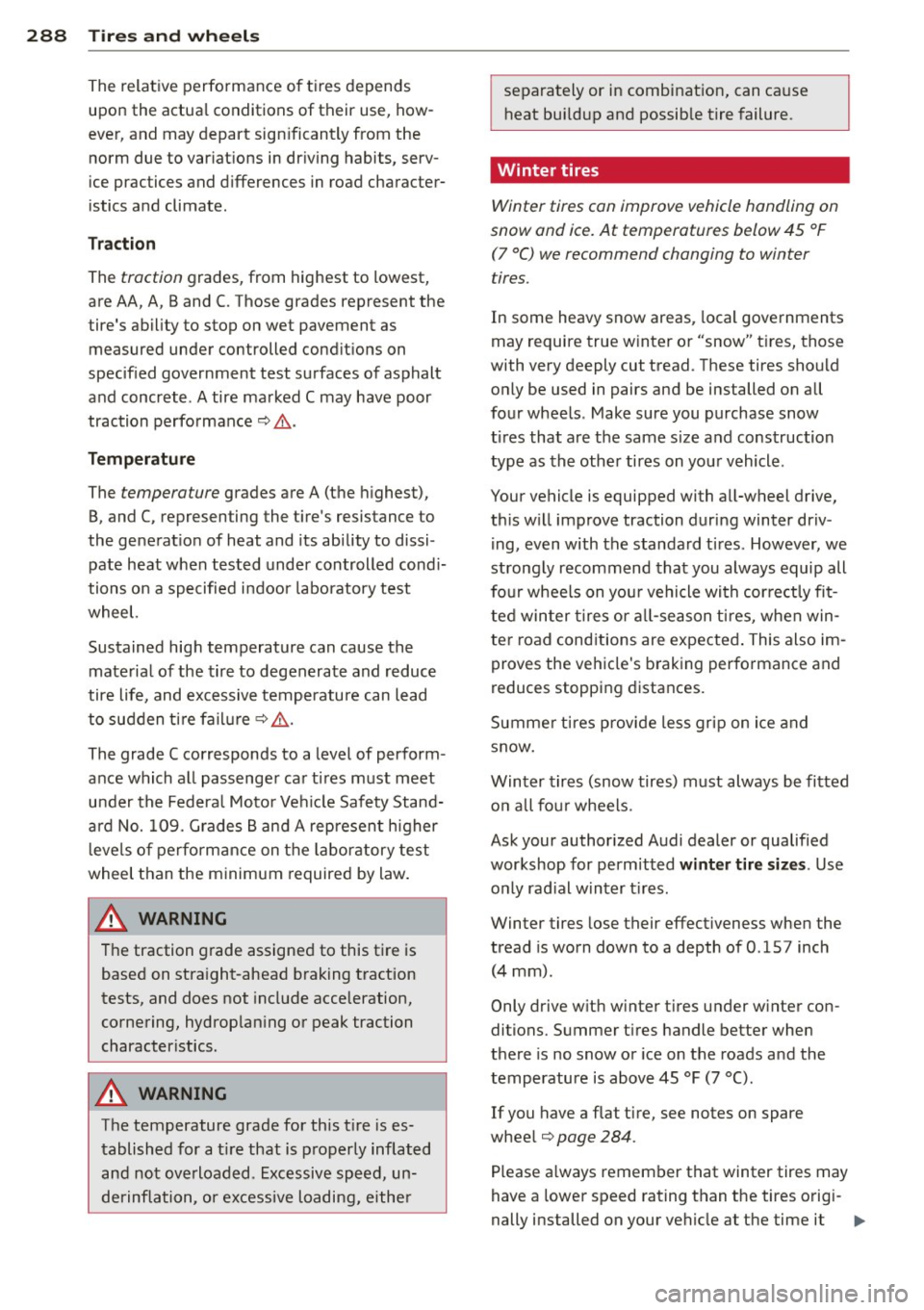
288 Tires and wheels
The relative performance of tires depends
upon the actual conditions of their use, how
ever, and may depart significantly from the norm due to variations in driving habits, serv
ice practices and differences in road character
istics and climate.
Traction
The traction grades , from highest to lowest,
are AA, A, Band
C. Those grades represent the
tire's ability to stop on wet pavement as measured under controlled conditions on
specified government test surfaces of asphalt
and concrete . A tire marked C may have poor
traction performance ¢.&, .
Temperature
The tempera ture grades are A (the highest),
B, and
C, representing the tire's resistance to
the generation of heat and its ability to dissi
pate heat when tested under controlled condi
tions on a specified indoor laboratory test
wheel.
Sustained high temperature can cause the
material of the tire to degenerate and reduce
tire life, and excessive temperature can lead
to sudden tire failure~.&, .
The grade
C corresponds to a level of perform
ance which all passenger car tires must meet under the Federal Motor Vehicle Safety Stand
ard No.
109. Grades Band A represent higher
levels of performance on the laboratory test
wheel than the minimum required by law.
A WARNING
The traction grade assigned to this tire is
based on straight-ahead braking traction
tests, and does not include acceleration,
cornering, hydroplaning or peak traction
characteristics.
A WARNING
The temperature grade for this tire is es
tablished for a tire that is properly inflated
and not overloaded . Excessive speed, un
derinflation, or excessive loading, either
-
separately or in combination, can cause heat buildup and possible tire failure.
Winter tires
Winter tires can improve vehicle handling on
snow and ice. At temperatures below 45 °F (7 °C) we recommend changing to winter
tires.
In some heavy snow areas, local governments
may require true winter or "snow" tires, those
with very deeply cut tread . These tires should
only be used in pairs and be installed on all
four wheels . Make sure you purchase snow
tires that are the same size and construction
type as the other tires on your vehicle .
Your vehicle is equipped with all-wheel drive,
this will improve traction during winter driv
ing, even with the standard tires. However, we
strongly recommend that you always equip all
four wheels on your vehicle with correctly fit
ted winter tires or all-season tires, when win
ter road conditions are expected. This also im
proves the vehicle's braking performance and
reduces stopping distances.
Summer tires provide less grip on ice and
snow.
Winter tires (snow tires) must always be fitted
on all four wheels.
Ask your authorized Audi dealer or qualified
workshop for permitted
winter tire sizes . Use
only radial winter tires.
Winter tires lose their effectiveness when the
tread is worn down to a depth of
O .15 7 inch
(4 mm).
Only drive with winter tires under winter con
ditions. Summer tires handle better when
there is no snow or ice on the roads and the
temperature is above 45 °F (7
°().
If you have a flat ti re, see notes on spare
wheel¢
page 284 .
Please always remember that winter tires may
have a lower speed rating than the tires origi-
nally installed on your vehicle at the time it .,.
Page 291 of 340
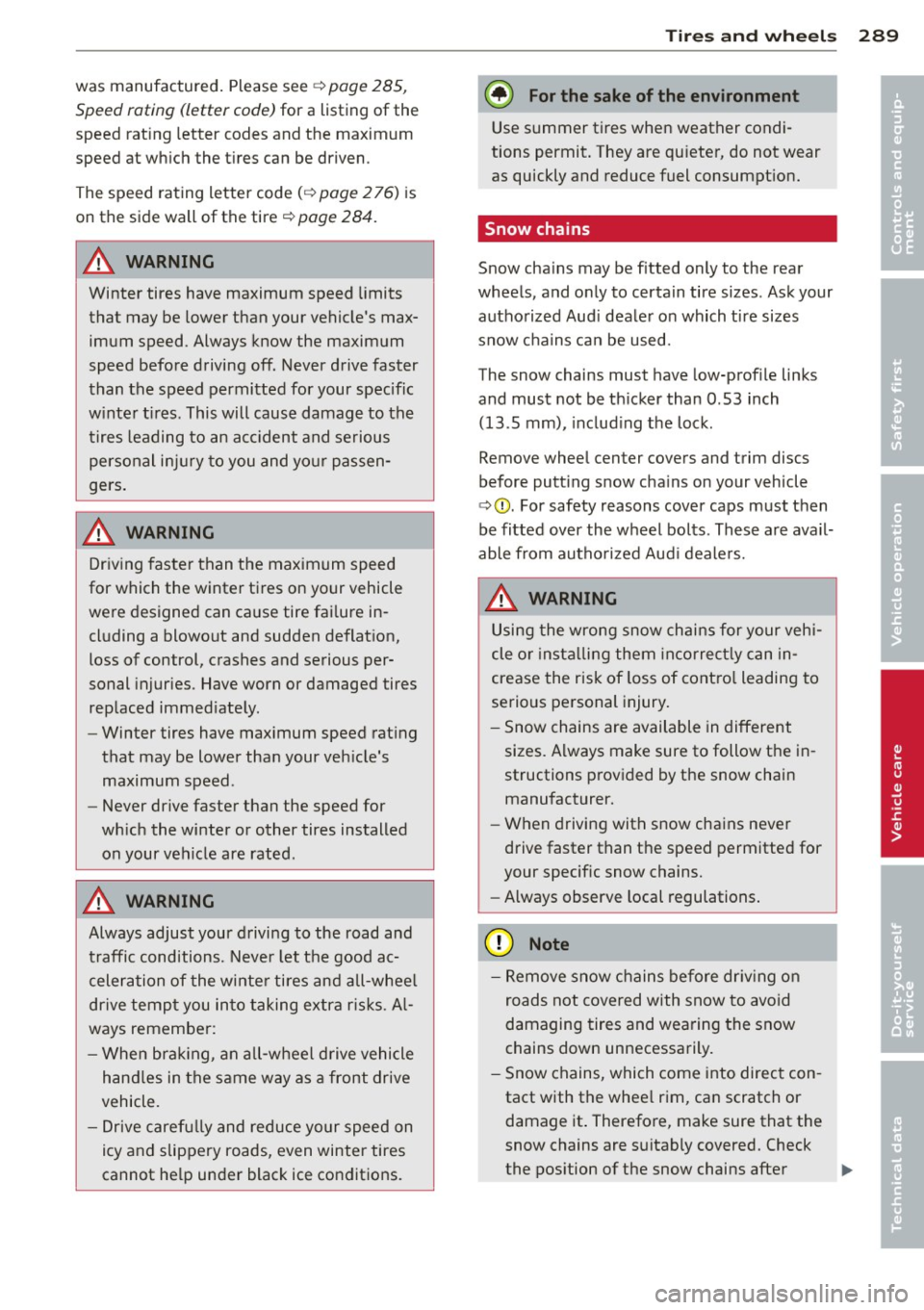
was manufactured. Please see ¢ page 285,
Speed rating (letter code)
for a listing of the
speed rat ing letter codes and the maximum
speed at wh ich the t ires can be driven .
The speed rating letter code (¢
page 2 76) is
on the side wall of the tire
c::> page 284.
A WARNING
Winter tires have maximum speed limits
that may be lower than your vehicle's max
imum speed. Always know the maximum
speed before driving off . Never drive faster
than the speed permitted for your specific
w inte r tires . This will cause damage to the
tires leading to an acc ident and serious
pe rsonal inj ury to you and yo ur passen
gers .
A WARNING
Driving faster than the maximum speed
for which the winter tires on your vehicle
were designed can ca use tire fai lure in
cluding a blowout and sudden deflation,
loss of control, crashes and serious per
sonal injuries . Have worn or damaged tires
replaced immed iately.
- Winter tires have maximum speed rat ing
that may be lower than your veh icle's
maximum speed .
- Never drive faster than the speed for
wh ich the winter or other tires installed
on your vehicle are rated .
A WARNING
Always adjust your driving to the road and
traffic conditions. Never let the good ac
celeration of the winte r tires and all-whee l
drive tempt you into taking extra r is k s . A l
ways remember:
- When bra king, an a ll-wheel drive vehicle
hand les in the same way as a front drive
vehicle.
- Drive carefu lly and reduce your speed on
icy and slippery roads, even winter tires
cannot he lp under black ice conditions.
Tire s an d wheel s 289
'
@) For the sake of the env ironment
Use summer tires when weather condi
tions permit. They are qu ieter, do not wear
as quickly and reduce fuel consumpt ion.
Snow chains
Snow cha ins may be fitted only to the rear
wheels, and only to certain tire sizes . Ask your
authorized Aud i dealer on which tire sizes
snow chains can be used.
The snow chains must have low-prof ile links
and must not be th icker than 0.53 inch
(13.5 mm) , includ ing the lock .
Remove wheel center covers and trim discs
before putt ing snow cha ins on your vehicle
c::> Q) . For safety reasons cover caps must then
be fitted over the wheel bolts. These are ava il
able from autho rized Aud i dealers.
A WARNING
Using the wrong snow chains for your vehi
cle or insta lling them incorrect ly can in
crease the risk of loss of cont ro l leading to
serious personal injury.
- Snow chains are available in different
sizes. Always make sure to follow the in
structions provided by the snow chain
manufacturer.
- When driving with snow chains never
drive faster than the speed permitted for
your specif ic snow chains.
- Always observe local regulations .
(D Note
-Remove snow chains before dr iv ing o n
roads not covered with snow to avoid
damaging tires and wearing the snow
chains down unnecessarily.
- Snow chains, which come into direct con
tact with the wheel rim , can scratch or
damage it . Therefore, make sure that the
snow chains are suitably covered. Check
the pos ition of the snow chains after
•
•
Page 293 of 340
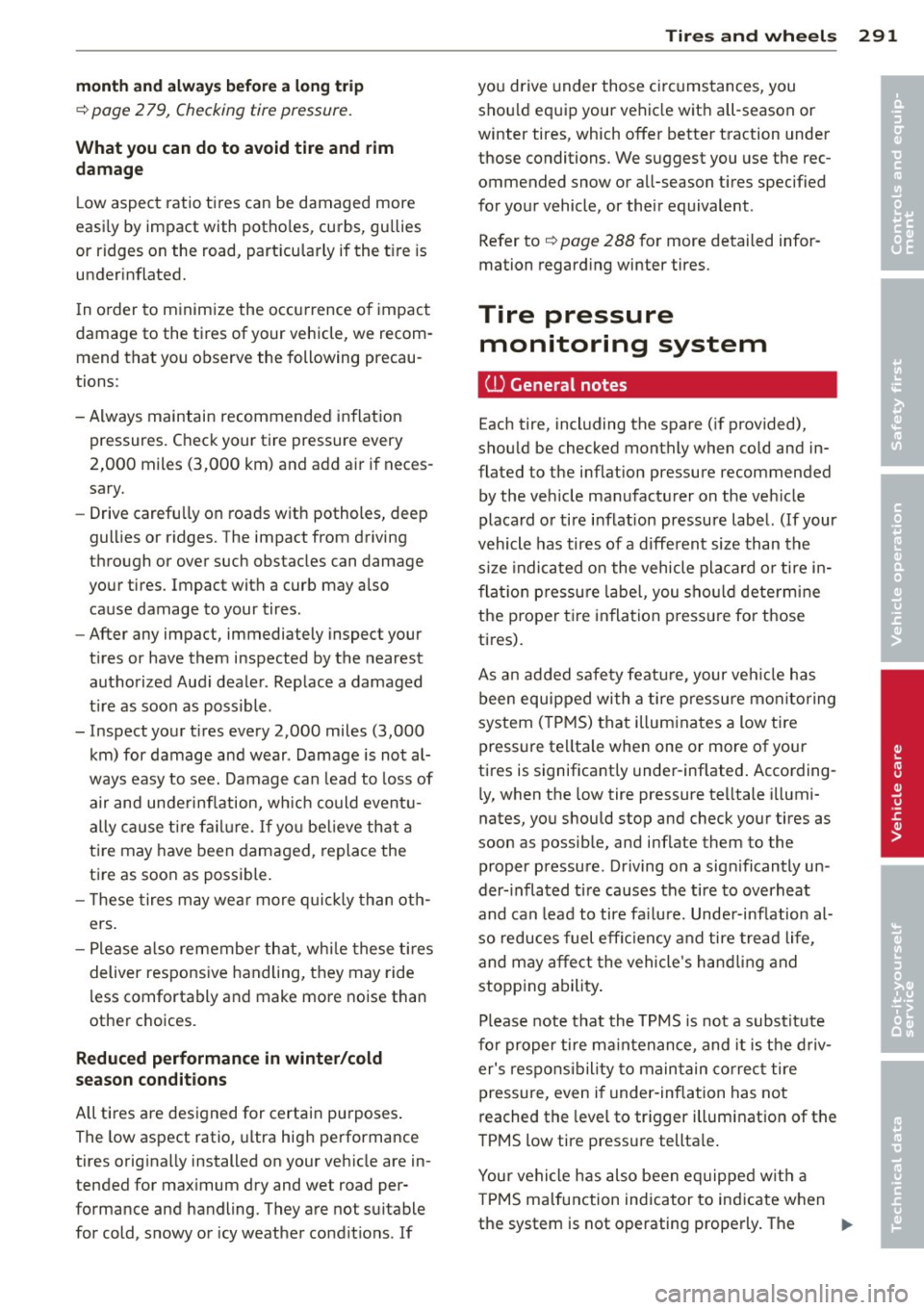
month and always before a long trip
¢ page 2 79, Checking tire pressure.
What you can do to avoid tire and rim
damage
L ow aspect ratio tires can be damaged more
easi ly by impact with potho les, curbs, gu llies
or ridges on the road, particularly if the tire is
underinflated.
I n order to minimize the occurrence o f impact
damage to the tires of your vehicle, we recom
mend that you observe the following precau
tions :
- Always maintain recommended inflation
pressures. Check your tire pressure every
2,000 miles (3,000 km) and add air if neces
sary.
- Drive carefully on roads with potholes, deep
gullies or ridges. The impact from driving
through or over such obstacles can damage
your tires. Impact with a curb may also cause damage to your tires.
- After any impact, immediately inspect your
t ires or have them inspected by the nearest
authorized Aud i dealer . Replace a damaged
t ir e as soon as possible .
- Inspect your t ires every 2,000 miles (3,000
km) for damage and wear . Damage is not al
ways easy to see. Damage can lead to loss of
air and unde rinflation, wh ich could eventu
ally cause tire failure. If you be lieve that a
tire may have been damaged, replace the
tire as soon as possible.
- These tires may wea r more quickly than oth
ers.
- Please also remember that, while these tires
deliver responsive handling, they may ride
less comfortably and make more noise than
other choices .
Reduced performance in winter/cold
season conditions
All tires are designed for certain purposes .
The low aspect ratio, ultra high performance
tires originally installed on your veh icle are in
tended for max imum dry and wet road per
formance and handling . They are not suitable
for cold, snowy or icy weather condit ions . If
Tires and wheels 2 91
you drive under those ci rcumstances, you
shou ld equip your vehicle with all-season or
winter tires, which offer better traction under
those conditions. We suggest you use the rec ommended snow or all-season t ires specified
for your vehicle, or their equivalent .
Refer to
¢ page 288 for more detailed infor
mation regarding winter tires .
Tire pressure
monitoring system
ill General notes
Each tire, incl uding the spare (if provided),
shou ld be checked monthly when co ld and in
flated to the inflation pressure recommended by the veh icle manufacturer on the veh icle
placard or tire inflation pressure label. (If your
vehicle has tires of a d ifferent size than the
s iz e indicated o n the vehicle placard or tire in
flat io n pressu re lab el, you sho uld determine
the p roper tire inflation pressure for those
tires).
As an added safe ty feature, your veh icle has
been equipped with a tire pressure monito ring
system ( TPMS) that illuminates a low ti re
pressure telltale when one or more of your
tires is significantly under-inflated. According
l y, when the low tire pressure te lltale illumi
nates, you should stop and check your tires as
soon as possible, and inflate them to the
proper pressure . Driving on a sign ificantly un
der- inflated t ire causes the tire to overheat
and can lead to tire fa ilure. Under-inflation al
so reduces fuel efficien cy and tire tread life,
and may affect the vehicle's hand ling and
stopping ability .
Please note that the TPMS is not a subst itute
for proper tire maintenance, and it is the driv
er's responsibility to maintain correct tire
pressure, even if under-inflation has not
reached the leve l to tr igger illumination of the
T PMS low tire pressure tellta le .
Your vehicle has also been eq uipped with a
T PMS ma lfunction indicator to indicate when
the system is not operating properly. The
ll-
•
•